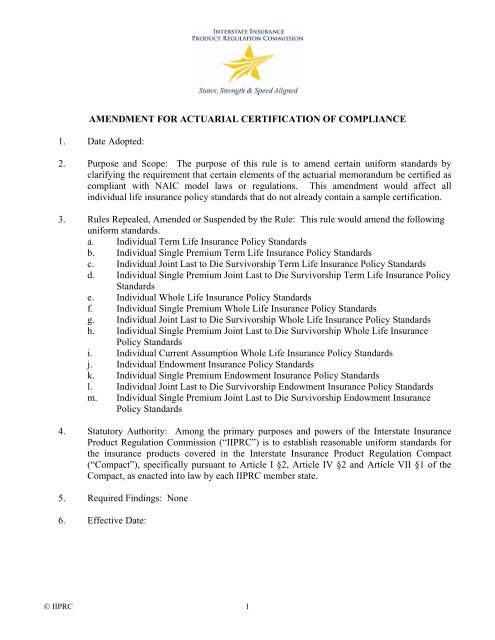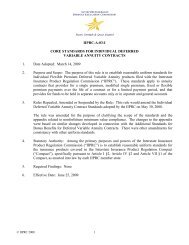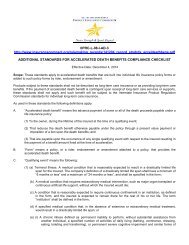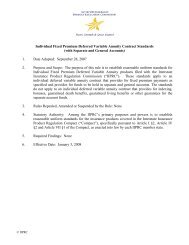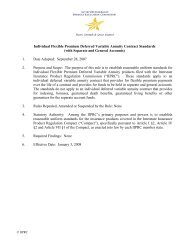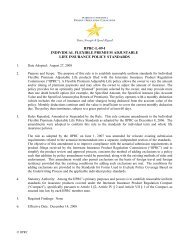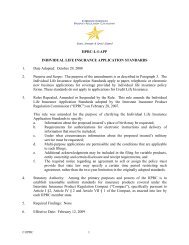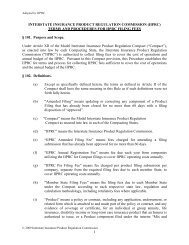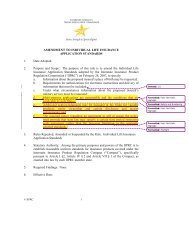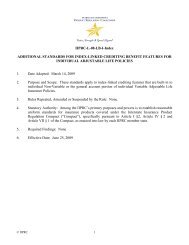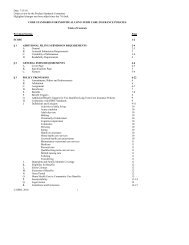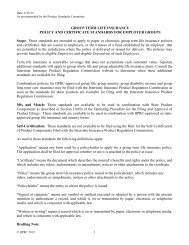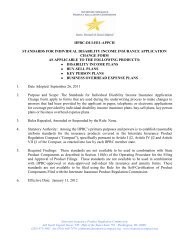amendment for actuarial certification of compliance - Interstate ...
amendment for actuarial certification of compliance - Interstate ...
amendment for actuarial certification of compliance - Interstate ...
You also want an ePaper? Increase the reach of your titles
YUMPU automatically turns print PDFs into web optimized ePapers that Google loves.
AMENDMENT FOR ACTUARIAL CERTIFICATION OF COMPLIANCE<br />
1. Date Adopted:<br />
2. Purpose and Scope: The purpose <strong>of</strong> this rule is to amend certain uni<strong>for</strong>m standards by<br />
clarifying the requirement that certain elements <strong>of</strong> the <strong>actuarial</strong> memorandum be certified as<br />
compliant with NAIC model laws or regulations. This <strong>amendment</strong> would affect all<br />
individual life insurance policy standards that do not already contain a sample <strong>certification</strong>.<br />
3. Rules Repealed, Amended or Suspended by the Rule: This rule would amend the following<br />
uni<strong>for</strong>m standards.<br />
a. Individual Term Life Insurance Policy Standards<br />
b. Individual Single Premium Term Life Insurance Policy Standards<br />
c. Individual Joint Last to Die Survivorship Term Life Insurance Policy Standards<br />
d. Individual Single Premium Joint Last to Die Survivorship Term Life Insurance Policy<br />
Standards<br />
e. Individual Whole Life Insurance Policy Standards<br />
f. Individual Single Premium Whole Life Insurance Policy Standards<br />
g. Individual Joint Last to Die Survivorship Whole Life Insurance Policy Standards<br />
h. Individual Single Premium Joint Last to Die Survivorship Whole Life Insurance<br />
Policy Standards<br />
i. Individual Current Assumption Whole Life Insurance Policy Standards<br />
j. Individual Endowment Insurance Policy Standards<br />
k. Individual Single Premium Endowment Insurance Policy Standards<br />
l. Individual Joint Last to Die Survivorship Endowment Insurance Policy Standards<br />
m. Individual Single Premium Joint Last to Die Survivorship Endowment Insurance<br />
Policy Standards<br />
4. Statutory Authority: Among the primary purposes and powers <strong>of</strong> the <strong>Interstate</strong> Insurance<br />
Product Regulation Commission (“IIPRC”) is to establish reasonable uni<strong>for</strong>m standards <strong>for</strong><br />
the insurance products covered in the <strong>Interstate</strong> Insurance Product Regulation Compact<br />
(“Compact”), specifically pursuant to Article I §2, Article IV §2 and Article VII §1 <strong>of</strong> the<br />
Compact, as enacted into law by each IIPRC member state.<br />
5. Required Findings: None<br />
6. Effective Date:<br />
© IIPRC 1
Date: 5/9/08<br />
Con<strong>for</strong>ming Amendment <strong>for</strong> Actuarial Certificate <strong>of</strong> Compliance<br />
As recommended by the Product Standards Committee<br />
[NOTE: The revisions shown are presented as an example <strong>of</strong> what is called <strong>for</strong> in this <strong>amendment</strong>. The<br />
actual model laws referred to in the Additional Submission requirement and the numbering <strong>of</strong> this<br />
requirement paragraph vary depending on the product type. Following this page is the <strong>amendment</strong> as it<br />
would appear in the complete Individual Term Life Insurance Policy Standards.]<br />
ADDITIONAL SUBMISSION REQUIREMENTS<br />
The following additional filing submission requirements shall apply.<br />
****<br />
(6) Include an <strong>actuarial</strong> memorandum prepared, dated and signed by the member <strong>of</strong> the American<br />
Academy <strong>of</strong> Actuaries who provides the following in<strong>for</strong>mation concerning the determination <strong>of</strong><br />
the non<strong>for</strong>feiture values:<br />
****<br />
(e)<br />
Include a statement at the end <strong>of</strong> the <strong>actuarial</strong> memorandum certifying that the<br />
non<strong>for</strong>feiture values available under the policy equal or exceed the minimums required<br />
under the NAIC Standard Non<strong>for</strong>feiture Law <strong>for</strong> Life Insurance, model #808, <strong>for</strong> all ages,<br />
rate classes and durations at which the policy is available; and<br />
****<br />
© IIPRC 2
Date: 5/9/08<br />
Con<strong>for</strong>ming Amendment <strong>for</strong> Actuarial Certificate <strong>of</strong> Compliance<br />
As recommended by the Product Standards Committee<br />
INDIVIDUAL TERM LIFE INSURANCE POLICY STANDARDS<br />
Scope: These standards are intended to apply to traditional <strong>for</strong>ms <strong>of</strong> individual term life insurance, including renewable term<br />
<strong>for</strong> various term periods, term to a specified age, and decreasing term insurance.<br />
Deposit term plans, plans that provide joint and last to die survivorship coverage, plans sold in connection with pre-need<br />
funeral arrangements, plans providing early duration reduced benefits, or plans providing return <strong>of</strong> premium benefits shall not<br />
be submitted under these standards.<br />
As used in these standards the following definitions apply:<br />
“Cash value” is the guaranteed cash value <strong>for</strong> the plan <strong>of</strong> insurance.<br />
“Cash surrender value” is the cash value reduced by indebtedness.<br />
Drafting Notes:<br />
Other terms may be used in the policy provided that they are used consistently.<br />
The references to “age” and “insured” do not preclude joint plans. It is intended that additional provisions will be added to<br />
the Specialized Products/Marketing section to address joint first to die coverage.<br />
The references to “policy” do not preclude Fraternal Benefit Societies from substituting “certificate” in their <strong>for</strong>ms.<br />
ADDITIONAL SUBMISSION REQUIREMENTS<br />
The following additional filing submission requirements shall apply:<br />
(1) All <strong>for</strong>ms filed <strong>for</strong> approval shall be included with the filing. Changes to a previously approved <strong>for</strong>m shall be<br />
highlighted. The specifications page <strong>of</strong> a policy shall be completed with hypothetical data that is realistic and<br />
consistent with the other contents <strong>of</strong> the policy and any required <strong>actuarial</strong> memorandum in support <strong>of</strong> non<strong>for</strong>feiture<br />
values.<br />
(2) If a filing is being submitted on behalf <strong>of</strong> a company, a letter or other document authorizing the firm to file on behalf<br />
<strong>of</strong> the company shall be included with the filing.<br />
(3) If the filing contains an insert page, an explanation <strong>of</strong> when the insert page will be used should be included in the<br />
filing.<br />
(4) If the specification page <strong>of</strong> the policy contains variable items, the submission shall include the Statement <strong>of</strong><br />
Variability. The submission shall also include a <strong>certification</strong> that any change or modification to a variable item shall<br />
be administered in accordance with the requirements in the Variability <strong>of</strong> In<strong>for</strong>mation section, including any<br />
requirements <strong>for</strong> prior approval <strong>of</strong> a change or modification.<br />
(5) Include a <strong>certification</strong> signed by a company <strong>of</strong>ficer that the policy <strong>for</strong>m has a minimum Flesch Score <strong>of</strong> 50.<br />
(6) Include an <strong>actuarial</strong> memorandum prepared, dated and signed by the member <strong>of</strong> the American Academy <strong>of</strong><br />
Actuaries who provides the following in<strong>for</strong>mation <strong>for</strong> all available guarantee periods concerning the determination<br />
<strong>of</strong> the non<strong>for</strong>feiture values:<br />
(a)<br />
A demonstration that the values <strong>of</strong> the policy comply with the standards <strong>of</strong> the NAIC Standard<br />
Non<strong>for</strong>feiture Law <strong>for</strong> Life Insurance, model #808. The smoker/nonsmoker mortality tables in the NAIC<br />
Model Rule (Regulation) Permitting Smoker/Nonsmoker Mortality Tables For Use In Determining<br />
Minimum Reserve Liabilities And Non<strong>for</strong>feiture Benefits, or the mortality rates which are a blend <strong>of</strong> the<br />
male and female rates in the NAIC Procedure For Permitting Same Minimum Non<strong>for</strong>feiture Standards For<br />
Men and Women Insured Under 1980 CSO And 1980 CET Mortality Tables, or any other mortality tables<br />
approved <strong>for</strong> use by the NAIC in determining minimum non<strong>for</strong>feiture values, may be used in determining<br />
© IIPRC 3
Date: 5/9/08<br />
Con<strong>for</strong>ming Amendment <strong>for</strong> Actuarial Certificate <strong>of</strong> Compliance<br />
As recommended by the Product Standards Committee<br />
minimum non<strong>for</strong>feiture values. The company shall use the composite mortality table <strong>for</strong> issue ages at<br />
which there is no distinction between smoker and nonsmoker mortality rates and continue to use the table<br />
<strong>for</strong> all future attained ages;<br />
(b)<br />
(c)<br />
(d)<br />
(e)<br />
(f)<br />
A description <strong>of</strong> the policy and policy provisions which affect the non<strong>for</strong>feiture values;<br />
The <strong>for</strong>mulae, assumptions and methodology used;<br />
Sample calculations <strong>for</strong> representative issue ages including issue age 35 if within the issue age range;<br />
Include a statement at the end <strong>of</strong> the <strong>actuarial</strong> memorandum certifying that the non<strong>for</strong>feiture values<br />
available under the policy equal or exceed the minimums required under the NAIC Standard Non<strong>for</strong>feiture<br />
Law <strong>for</strong> Life Insurance, model #808, <strong>for</strong> all ages, rate classes and durations at which the policy is available;<br />
and<br />
The range <strong>of</strong> issue ages and the minimum specified amount <strong>for</strong> which the policy will be issued.<br />
(7) A description <strong>of</strong> any innovative or unique features <strong>of</strong> each policy <strong>for</strong>m.<br />
(8) State whether the policy is sex-distinct or unisex. If sex-distinct, the company shall confirm that the policy will not<br />
be issued in any employer-employee plans that are subject to the Norris decision and/or Title VII <strong>of</strong> the Civil Rights<br />
Act <strong>of</strong> 1964.<br />
(9) Appropriate policy pages completed <strong>for</strong> each type <strong>of</strong> rating used by the company; <strong>for</strong> example, percentage <strong>of</strong><br />
standard class premium, extra premium, temporary or permanent flat charge per $1,000 to demonstrate how the<br />
policy will disclose the rates and charges applicable to each type <strong>of</strong> rating class. This is not intended to require pages<br />
<strong>for</strong> all rating classes, but only examples <strong>of</strong> each type <strong>of</strong> rating applied by the company.<br />
(10) If the policy is <strong>for</strong> use with more than one term plan, the submission shall include a separate set <strong>of</strong> uniquely<br />
numbered specification pages <strong>for</strong> each term plan being submitted <strong>for</strong> approval, along with a separate <strong>actuarial</strong><br />
memorandum <strong>for</strong> each plan.<br />
VARIABILITY OF INFORMATION<br />
(1) The company may identify items that will be considered variable only in the specification page. The item shall be<br />
bracketed or otherwise marked to denote variability. The submission shall include a Statement <strong>of</strong> Variability that<br />
will discuss the conditions under which each variable item may change.<br />
(2) Any change or modification shall be limited to only new issues <strong>of</strong> the policy and shall not apply to in <strong>for</strong>ce policies.<br />
(3) The following items shall only be changed upon prior approval:<br />
(a)<br />
(b)<br />
(c)<br />
(d)<br />
(e)<br />
(f)<br />
Mortality tables;<br />
Interest rate <strong>for</strong> cash value and non<strong>for</strong>feiture benefits;<br />
Term periods;<br />
Length <strong>of</strong> level premium periods;<br />
Decreasing term death benefit schedules; and<br />
Settlement option tables.<br />
(4) In addition to the items listed in Paragraph (3) above, a change or modification to any other item not specifically<br />
listed that may affect the derivation and <strong>compliance</strong> <strong>of</strong> policy values with any required minimum non<strong>for</strong>feiture<br />
values shall also be subject to prior approval. All submissions <strong>for</strong> approval <strong>of</strong> a change shall be accompanied by a<br />
© IIPRC 4
Date: 5/9/08<br />
Con<strong>for</strong>ming Amendment <strong>for</strong> Actuarial Certificate <strong>of</strong> Compliance<br />
As recommended by the Product Standards Committee<br />
demonstration, if applicable, signed by a member <strong>of</strong> the American Academy <strong>of</strong> Actuaries, that the policy continues<br />
to comply with the NAIC Standard Non<strong>for</strong>feiture Law <strong>for</strong> Life Insurance, model #808.<br />
(5) The company may also identify product specifications that may be changed without prior notice or approval, as long<br />
as the Statement <strong>of</strong> Variability presents reasonable and realistic ranges <strong>for</strong> the item. These items include conversion<br />
periods, conversion credits, minimum loan amounts, charges <strong>for</strong> supplemental benefits and options, any ages<br />
assumed in the calculation <strong>of</strong> benefits and options, and policy loan interest rates. A zero entry <strong>for</strong> a range <strong>of</strong> values<br />
on the specifications page <strong>for</strong> any benefit or credit provided <strong>for</strong> in the language <strong>of</strong> the policy is unacceptable. Any<br />
change to a range requires a re-filing <strong>for</strong> prior approval and shall be accompanied by a demonstration, if applicable,<br />
signed by a member <strong>of</strong> the American Academy <strong>of</strong> Actuaries, that the policy continues to comply with the NAIC<br />
Standard Non<strong>for</strong>feiture Law <strong>for</strong> Life Insurance, model #808.<br />
(6) Notwithstanding Paragraph (1) above, items such as the insurance department address and telephone number,<br />
company address and telephone number, <strong>of</strong>ficer titles, and signatures <strong>of</strong> <strong>of</strong>ficers located in other areas <strong>of</strong> the policy<br />
may be denoted as variable and changed without notice or prior approval.<br />
Drafting Note: The working group believes the above provisions address the issue. Industry may provide examples with<br />
specific detail to demonstrate the kinds <strong>of</strong> variability that they would seek in policies that is not contemplated by this section.<br />
READABILITY REQUIREMENTS<br />
(1) The policy text shall achieve a minimum score <strong>of</strong> 50 on the Flesch reading ease test or an equivalent score on any<br />
other approved comparable reading test. See Appendix A <strong>for</strong> Flesch methodology.<br />
(2) The policy shall be presented, except <strong>for</strong> specification pages, schedules and tables, in not less than ten point type,<br />
one point leaded.<br />
(3) The style, arrangement and overall appearance <strong>of</strong> the policy shall give no undue prominence to any portion <strong>of</strong> the<br />
text <strong>of</strong> the policy or to any endorsements or riders.<br />
(4) The policy shall contain a table <strong>of</strong> contents or an index <strong>of</strong> the principal sections <strong>of</strong> the policy, if the policy has more<br />
than 3,000 words printed on three or fewer pages <strong>of</strong> text or if the policy has more than three pages regardless <strong>of</strong> the<br />
number <strong>of</strong> words.<br />
GENERAL FORM REQUIREMENTS<br />
COVER PAGE<br />
(1) The full corporate name, including city and state <strong>of</strong> the company shall appear in prominent print on the<br />
cover page <strong>of</strong> the policy. “Prominent print” means, <strong>for</strong> example, all capital letters, contrasting color,<br />
underlined or otherwise differentiated from the other type on the <strong>for</strong>m.<br />
(2) A marketing name or logo may also be used on the cover page <strong>of</strong> the policy provided that the marketing name or<br />
logo does not mislead as to the identity <strong>of</strong> the company.<br />
(3) The company’s complete mailing address <strong>for</strong> the home <strong>of</strong>fice or the <strong>of</strong>fice that will administer the policy shall<br />
appear on the cover page <strong>of</strong> the policy. The cover page <strong>of</strong> the policy shall include a telephone number <strong>of</strong> the<br />
company and, if available, some method <strong>of</strong> Internet communication. The telephone number <strong>of</strong> the insurance<br />
department <strong>of</strong> the state where the policy is delivered or issued <strong>for</strong> delivery is also required on either the cover page<br />
or the first specifications page.<br />
(4) Two signatures <strong>of</strong> company <strong>of</strong>ficers shall appear on the cover page <strong>of</strong> the policy.<br />
(5) A Right to Examine Policy provision that shall appear on the cover page <strong>of</strong> the policy or is visible without opening<br />
the policy.<br />
© IIPRC 5
Date: 5/9/08<br />
Con<strong>for</strong>ming Amendment <strong>for</strong> Actuarial Certificate <strong>of</strong> Compliance<br />
As recommended by the Product Standards Committee<br />
(6) A <strong>for</strong>m identification number shall appear at the bottom <strong>of</strong> the <strong>for</strong>m in the lower left hand corner <strong>of</strong> the <strong>for</strong>m. The<br />
<strong>for</strong>m number shall be adequate to distinguish the <strong>for</strong>m from all others used by the company. The <strong>for</strong>m number shall<br />
include a prefix <strong>of</strong> ICCxx (where xx represents the appropriate year the <strong>for</strong>m was submitted <strong>for</strong> filing) to indicate it<br />
has been approved by the <strong>Interstate</strong> Insurance Product Regulation Commission.<br />
(7) A brief description that shall appear in prominent print on the cover page <strong>of</strong> the policy or be visible without opening<br />
the policy. The brief description shall contain at least the following in<strong>for</strong>mation:<br />
(a)<br />
(b)<br />
(c)<br />
A caption <strong>of</strong> the type <strong>of</strong> term coverage provided; <strong>for</strong> example, annually renewable term life insurance or<br />
decreasing term life insurance;<br />
An indication <strong>of</strong> “convertible” if the policy is convertible; and an indication as to whether the policy is<br />
renewable or non-renewable; participating or nonparticipating; and<br />
An indication <strong>of</strong> any war risk exclusion in the policy.<br />
(8) For any policy that is convertible, the cover page shall include the conversion period unless it is shown on the<br />
specification page.<br />
SPECIFICATIONS PAGE<br />
(1) The specifications page shall include the benefits, amounts, durations, premium in<strong>for</strong>mation, and any other benefit<br />
data applicable to the insured.<br />
(2) If the policy is a participating policy, the specifications page shall indicate that the dividends are not guaranteed. In<br />
addition, if the company does not intend to credit dividends, then the specifications page shall state that dividends<br />
are not expected or anticipated to be paid.<br />
(3) For any policy that is convertible, the specifications page shall include the conversion period unless it is shown on<br />
the cover page.<br />
FAIRNESS<br />
(1) The policy shall not contain inconsistent, ambiguous, unfair, inequitable or misleading clauses, provisions that are<br />
against public policy as determined by the <strong>Interstate</strong> Insurance Product Regulation Commission, or contain<br />
exceptions and conditions that unreasonably affect the risk purported to be assumed in the general coverage <strong>of</strong> the<br />
policy.<br />
POLICY PROVISIONS<br />
AMENDMENTS<br />
(1) The policy shall not provide <strong>for</strong> unilateral <strong>amendment</strong>s that reduce or eliminate benefits or coverage, or impair or<br />
invalidate any right granted to the owner under the policy except <strong>for</strong> <strong>amendment</strong>s to con<strong>for</strong>m to changes in any<br />
applicable provisions or requirements <strong>of</strong> the Internal Revenue Code.<br />
(2) Amendments to approved <strong>for</strong>ms are subject to prior approval.<br />
(3) Subject to the prohibition against unfair discrimination, any <strong>amendment</strong> may apply prospectively to new owners<br />
and, if applicable, to new contributions <strong>of</strong> existing owners.<br />
Drafting Note: These standards are modified, as required or permitted by law, to enable fraternals to implement their<br />
respective articles and bylaws. See Appendix B.<br />
© IIPRC 6
Date: 5/9/08<br />
Con<strong>for</strong>ming Amendment <strong>for</strong> Actuarial Certificate <strong>of</strong> Compliance<br />
As recommended by the Product Standards Committee<br />
ARBITRATION<br />
(1) Only arbitration provisions that permit voluntary post-dispute binding arbitration shall be allowed in policy <strong>for</strong>ms.<br />
With respect to such a provision, the following guidelines apply:<br />
(a)<br />
(b)<br />
(c)<br />
(d)<br />
Arbitration shall be conducted in accordance with the rules <strong>of</strong> the American Arbitration Association<br />
("AAA"), be<strong>for</strong>e a panel <strong>of</strong> 3 neutral arbitrators who are knowledgeable in the field <strong>of</strong> life insurance and<br />
appointed from a panel list provided by the AAA.<br />
Arbitration shall be held in the city or county where the policy owner or beneficiary lives.<br />
The cost <strong>of</strong> arbitration shall be paid by the company, to include any deposits or administrative fee required<br />
to commence a dispute in arbitration, as well as any other fee including the arbitrator’s fee.<br />
Where there is any inconsistency between these guidelines and AAA rules, these guidelines control.<br />
Drafting Note: These standards are modified, as required or permitted by law, to enable fraternals to implement their<br />
respective articles and bylaws. See Appendix B.<br />
ASSIGNMENT<br />
(1) The policy shall contain an assignment provision. The policy shall not include any restrictions on the availability <strong>of</strong><br />
policy assignments, except in situations where restrictions are required <strong>for</strong> purposes <strong>of</strong> satisfying applicable laws or<br />
regulations.<br />
(2) The policy shall describe procedures <strong>for</strong> assignments and shall state that assignments, unless otherwise specified by<br />
the owner, shall take effect on the date the notice <strong>of</strong> assignment is signed by the owner, subject to any payments<br />
made or actions taken by the company prior to receipt <strong>of</strong> this notice.<br />
(3) The policy may state that the company shall not be liable <strong>for</strong> the validity <strong>of</strong> the assignment.<br />
Drafting Note: Restrictions on assignment in policy <strong>for</strong>ms such as right <strong>of</strong> first refusal or first <strong>of</strong>fer provisions are<br />
prohibited by Item (1).<br />
BENEFICIARY<br />
(1) The policy shall contain a beneficiary provision. The provision shall describe the procedures <strong>for</strong> designating or<br />
changing the beneficiaries, or <strong>for</strong> selecting default beneficiaries as may be necessary, and indicating when such<br />
designation is effective. The policy shall not include any restriction on change <strong>of</strong> beneficiary other than <strong>for</strong> the<br />
purposes <strong>of</strong> satisfying applicable laws or regulations.<br />
(2) The policy shall state that changes in beneficiary, unless otherwise specified by the owner, shall take effect on the<br />
date the notice <strong>of</strong> change is signed by the owner, subject to any payments made or actions taken by the company<br />
prior to receipt <strong>of</strong> this notice.<br />
(3) If irrevocable beneficiaries are referenced in the policy, the policy shall explain that such a beneficiary cannot be<br />
changed without the consent <strong>of</strong> the irrevocable beneficiary.<br />
CONFORMITY WITH INTERSTATE INSURANCE PRODUCT REGULATION COMMISSION STANDARDS<br />
(1) The policy shall state that it was approved under the authority <strong>of</strong> the <strong>Interstate</strong> Insurance Product Regulation<br />
Commission and issued under the Commission standards. The policy shall also state that any provision <strong>of</strong><br />
the policy that on the provision’s effective date is in conflict with <strong>Interstate</strong> Insurance Product Regulation<br />
Commission standards <strong>for</strong> this product type is hereby amended to con<strong>for</strong>m to the <strong>Interstate</strong> Insurance<br />
Product Regulation Commission standards <strong>for</strong> this product type as <strong>of</strong> the provision’s effective date.<br />
© IIPRC 7
Date: 5/9/08<br />
Con<strong>for</strong>ming Amendment <strong>for</strong> Actuarial Certificate <strong>of</strong> Compliance<br />
As recommended by the Product Standards Committee<br />
CONVERSION<br />
(1) A policy that is convertible shall contain a provision describing the conditions <strong>of</strong> the conversion privilege. The<br />
conversion period shall be shown on the cover page or specifications page.<br />
(2) The conversion provision shall describe the following in<strong>for</strong>mation, if applicable:<br />
(a)<br />
(b)<br />
(c)<br />
(d)<br />
(e)<br />
(f)<br />
When the first premium is due;<br />
What supplemental benefits included in the policy may be converted;<br />
The type or types <strong>of</strong> policies to which a conversion may be made;<br />
The minimum and maximum amount <strong>of</strong> coverage available <strong>for</strong> conversion;<br />
The criteria used to determine the premiums at the point <strong>of</strong> conversion; and<br />
Any evidence <strong>of</strong> insurability requirements. Such evidence would be limited to amounts in excess <strong>of</strong> the<br />
amount <strong>of</strong> life insurance in effect at the time <strong>of</strong> conversion and any supplemental benefits unrelated to the<br />
life risk.<br />
(3) The policy may provide that a discount is applied to the conversion policy total premium in the year <strong>of</strong> conversion.<br />
The discount or the method by which the discount is calculated shall be described in the policy.<br />
(4) The policy shall provide that the incontestability and suicide provisions attributable to the coverage converted will<br />
run from the date <strong>of</strong> the original policy. If the new policy includes additional coverage <strong>for</strong> which evidence <strong>of</strong><br />
insurability was given, new incontestability and suicide provisions may apply to that coverage.<br />
DEATH BENEFIT PROCEEDS<br />
(1) The policy shall describe how the death benefit proceeds are determined and shall describe all death benefit options<br />
available under the policy.<br />
(2) The policy shall contain a provision <strong>for</strong> the payment <strong>of</strong> interest on the death benefit, as follows:<br />
(a)<br />
(b)<br />
(c)<br />
Interest shall accrue and be payable from the date <strong>of</strong> death.<br />
Interest shall accrue at the rate or rates applicable to the policy <strong>for</strong> funds left on deposit or, if the company<br />
has not established a rate <strong>for</strong> funds left on deposit, at the Two Year Treasury Constant Maturity Rate as<br />
published by the Federal Reserve. In determining the effective annual rate or rates, the company shall use<br />
the rate in effect on the date <strong>of</strong> death.<br />
Interest shall accrue at the effective annual rate determined in Item (b) above, plus additional interest at a<br />
rate <strong>of</strong> 10% annually beginning with the date that is 31 calendar days from the latest <strong>of</strong> Items (i), (ii) and<br />
(iii) to the date the claim is paid, where it is:<br />
(i)<br />
(ii)<br />
(iii)<br />
The date that due pro<strong>of</strong> <strong>of</strong> death is received by the company;<br />
The date the company receives sufficient in<strong>for</strong>mation to determine its liability, the extent <strong>of</strong> the<br />
liability, and the appropriate payee legally entitled to the proceeds; and<br />
The date that legal impediments to payment <strong>of</strong> proceeds that depend on the action <strong>of</strong> parties other<br />
than the company are resolved and sufficient evidence <strong>of</strong> the same is provided to the company.<br />
Legal impediments to payment include, but are not limited to (a) the establishment <strong>of</strong><br />
guardianships and conservatorships; (b) the appointment and qualification <strong>of</strong> trustees, executors<br />
© IIPRC 8
Date: 5/9/08<br />
Con<strong>for</strong>ming Amendment <strong>for</strong> Actuarial Certificate <strong>of</strong> Compliance<br />
As recommended by the Product Standards Committee<br />
and administrators; and (c) the submission <strong>of</strong> in<strong>for</strong>mation required to satisfy a state and federal<br />
reporting requirements.<br />
(3) The death benefit proceeds paid shall be at least equal to the death benefit <strong>of</strong> the policy and any riders that are<br />
payable, plus any dividend values in the policy at the time <strong>of</strong> death, less any indebtedness and plus or minus any<br />
premium adjustments with interest. If death occurs during a period <strong>for</strong> which premium has been paid, the company<br />
shall add to the policy proceeds a refund <strong>of</strong> any premium actually paid <strong>for</strong> any period beyond the end <strong>of</strong> the policy<br />
month.<br />
(4) The policy may require that due pro<strong>of</strong> <strong>of</strong> the death <strong>of</strong> the insured will consist <strong>of</strong> a certified copy <strong>of</strong> the death<br />
certificate <strong>of</strong> the insured, or other lawful evidence providing equivalent in<strong>for</strong>mation, and pro<strong>of</strong> <strong>of</strong> the claimant’s<br />
interest in the proceeds.<br />
DEPENDENT AND FAMILY MEMBER COVERAGE<br />
(1) The policy may provide coverage <strong>for</strong> dependents and family members. If the policy provides such coverage:<br />
(a)<br />
(b)<br />
The policy shall comply with the applicable state law where the policy is delivered or issued <strong>for</strong> delivery,<br />
with respect to the coverage and benefits available to a person who is in a legally-sanctioned domestic<br />
partnership or civil union and to their families, or available to a person who is in a legally-sanctioned<br />
marriage with the insured and to their families; and<br />
Nothing in this provision shall be construed as requiring any company to provide coverage or benefits to<br />
any person who is in a domestic partnership, civil union or marriage or to their families in a state where<br />
such relationships are not legally recognized.<br />
ENTIRE CONTRACT<br />
(1) The policy shall contain a provision regarding what constitutes the entire contract between the company and the<br />
owner. No document may be included by reference.<br />
(2) All statements made by the applicant <strong>for</strong> the issuance, reinstatement or renewal <strong>of</strong> a policy shall, in the absence <strong>of</strong><br />
fraud, be deemed representations and not warranties.<br />
(3) If the application is to be a part <strong>of</strong> the policy, the entire contract provision shall state that the application is a part <strong>of</strong><br />
the contract.<br />
Drafting Note: These standards are modified, as required or permitted by law, to enable fraternals to implement their<br />
respective articles and bylaws. See Appendix B.<br />
EXCLUSIONS<br />
(1) Any exclusion applied to the death benefit <strong>of</strong> the policy, except <strong>for</strong> accidental death benefits, shall be limited to the<br />
following:<br />
(a)<br />
War<br />
(I)<br />
Regarding military exclusions, risk <strong>of</strong> death may be excluded under the following conditions:<br />
(A)<br />
As a result <strong>of</strong> war or act <strong>of</strong> war, if the cause <strong>of</strong> death occurs while the insured is serving<br />
in the military, naval or air <strong>for</strong>ces <strong>of</strong> any country, combination <strong>of</strong> countries or<br />
international organization, provided such death occurs while in such <strong>for</strong>ces or within six<br />
months after termination <strong>of</strong> service in such <strong>for</strong>ces; or<br />
(B)<br />
© IIPRC 9<br />
As a result <strong>of</strong> the special hazards incident to service in the military, naval or air <strong>for</strong>ces <strong>of</strong><br />
any country, combination <strong>of</strong> countries or international organization, if the cause <strong>of</strong> death<br />
occurs while the insured is serving in such <strong>for</strong>ces and is outside the home area, provided
Date: 5/9/08<br />
Con<strong>for</strong>ming Amendment <strong>for</strong> Actuarial Certificate <strong>of</strong> Compliance<br />
As recommended by the Product Standards Committee<br />
such death occurs outside the home area or within six months after the insured’s return to<br />
the home area or area in such <strong>for</strong>ces or within six months after the termination <strong>of</strong> service<br />
in such <strong>for</strong>ces, whichever is earlier.<br />
(II)<br />
Regarding non-combatant civilian exclusions, risk <strong>of</strong> death may be excluded under the following<br />
conditions:<br />
(A)<br />
(B)<br />
As a result <strong>of</strong> war or an act <strong>of</strong> war while the insured is serving in any civilian noncombatant<br />
unit serving with such <strong>for</strong>ces, provided such death occurs while serving in<br />
such units or within six months after termination <strong>of</strong> service in such units, whichever is<br />
earlier.<br />
As a result <strong>of</strong> the special hazards incident to service in any civilian non-combatant unit<br />
serving with such <strong>for</strong>ces, if the cause <strong>of</strong> death occurs while the insured is serving in such<br />
units and is outside the home area, provided such death occurs outside the home area or<br />
within six months after the insured’s return to the home area while serving in such units<br />
or within six months after the termination <strong>of</strong> service in such units, whichever is earlier.<br />
(III)<br />
Regarding civilian exclusions, risk <strong>of</strong> death may be excluded under the following conditions:<br />
(A)<br />
As a result <strong>of</strong> war or an act <strong>of</strong> war, within two years from the date <strong>of</strong> issue <strong>of</strong> the policy,<br />
while the insured is not serving in such <strong>for</strong>ces or units, if the cause <strong>of</strong> death occurs while<br />
the insured is outside the home area, provided such death occurs outside the home area or<br />
within six months after the insured’s return to the home area.<br />
(IV)<br />
“Home area” is defined to include at least the 50 states <strong>of</strong> the United States and its territories, the<br />
District <strong>of</strong> Columbia and Canada. “War” includes, but is not limited to, declared war, and armed<br />
aggression by one or more countries resisted on orders <strong>of</strong> any other country, combination <strong>of</strong><br />
countries or international organization. “Act <strong>of</strong> war” means any act peculiar to military, naval or<br />
air operations in time <strong>of</strong> war.<br />
(b)<br />
Avocation, Aviation and Occupation:<br />
The policy may exclude from coverage by rider or endorsement death due to a specific avocation, aviation<br />
or occupation based on representations about activities or occupation, made by the proposed insured at the<br />
time <strong>of</strong> application, if the decision by the company is determined based on the established, not unfairly<br />
discriminatory underwriting standards in place <strong>for</strong> the company at the time <strong>of</strong> application.<br />
(2) Any amount payable as a result <strong>of</strong> death from an excluded act shall be at least equal to the greater <strong>of</strong> the gross<br />
premiums paid <strong>for</strong> the policy or the policy reserve, each adjusted <strong>for</strong> dividend values, loans, partial withdrawals and<br />
surrenders.<br />
(3) The policy may not exclude from coverage death due to any specific medical condition.<br />
GRACE PERIOD<br />
(1) The policy shall contain a grace period provision and include the conditions <strong>of</strong> the provision.<br />
(2) A minimum <strong>of</strong> 31-day grace period shall be provided <strong>for</strong> the payment <strong>of</strong> any premium due except the first.<br />
(3) The coverage shall continue in <strong>for</strong>ce during the grace period.<br />
(4) The policy may provide that if the insured dies during the grace period the overdue premium will be deducted in any<br />
settlement under the policy. Interest cannot be added to any overdue premium.<br />
© IIPRC 10
Date: 5/9/08<br />
Con<strong>for</strong>ming Amendment <strong>for</strong> Actuarial Certificate <strong>of</strong> Compliance<br />
As recommended by the Product Standards Committee<br />
(5) The company may not require that the premium be received within the grace period. The owner shall have the entire<br />
grace period within which to remit payment. Any payments sent by U.S. mail shall be postmarked within the grace<br />
period.<br />
INCONTESTABILITY<br />
(1) The policy shall contain an incontestability provision and include the conditions <strong>of</strong> the provision.<br />
(2) The contestable period shall be no greater than two years from the date <strong>of</strong> issue during the lifetime <strong>of</strong> the insured.<br />
(3) The contract may allow a separate contestable period no greater than two years after the date <strong>of</strong> any change<br />
requiring underwriting. The contest shall be limited to the change and the statements provided <strong>for</strong> the change.<br />
(4) Coverage may only be contested based on a statement contained in an application made a part <strong>of</strong> the contract. If the<br />
company expects to rely on an application to contest the policy, the company shall attach to or endorse the<br />
application as part <strong>of</strong> the policy. The statement on which the contest is based shall be material to the risk accepted or<br />
the hazard assumed by the company.<br />
(5) The policy may only include the following exceptions to the incontestability provision:<br />
(a)<br />
(b)<br />
(c)<br />
Non-payment <strong>of</strong> premium;<br />
At the option <strong>of</strong> the company, provisions related to benefits in the event <strong>of</strong> total and permanent disability<br />
and provisions related to accidental death benefit coverage; and<br />
Fraud in the procurement <strong>of</strong> the policy, when permitted by applicable law in the state where the policy is<br />
delivered or issued <strong>for</strong> delivery.<br />
(6) A preliminary term coverage to precede another plan <strong>of</strong> insurance may contain incontestability provisions and the<br />
successor plan shall compute the time period from the date <strong>of</strong> issue <strong>of</strong> the preliminary term coverage.<br />
(7) Policy <strong>for</strong>ms shall not contain an incontestability provision that excludes the riders that may be attached to the <strong>for</strong>m<br />
unless those riders contain their own incontestability provisions.<br />
(8) A policy that is reinstated may be contested in accordance with Paragraph (6) <strong>of</strong> the Reinstatement section.<br />
LOANS<br />
(1) A policy that develops cash value may provide <strong>for</strong> a loan provision.<br />
Drafting Note: “May” is acceptable since loans are not required by statute <strong>for</strong> term plans. However, the provision would be<br />
mandatory <strong>for</strong> permanent life plans.<br />
(2) The policy shall contain the conditions <strong>of</strong> a loan, if loans are available, including:<br />
(a)<br />
(b)<br />
(c)<br />
A statement shall be included that the policy shall be the sole security <strong>of</strong> the loan.<br />
The loan value shall be equal to the cash value at the end <strong>of</strong> the current policy year, plus the cash value <strong>of</strong><br />
any dividend additions. The owner has the option to take less than the loan value, subject to a reasonable<br />
company minimum loan requirement.<br />
The policy shall describe the loan interest rate. The loan interest rate, including any added administrative<br />
fees associated with the loan, shall be at a maximum fixed annual rate <strong>of</strong> 8% in arrears or a variable rate<br />
determined in accordance with the NAIC Model Policy Loan Interest Rate Bill, model #590. The company<br />
may not charge any additional fees or expenses <strong>for</strong> the loan.<br />
© IIPRC 11
Date: 5/9/08<br />
Con<strong>for</strong>ming Amendment <strong>for</strong> Actuarial Certificate <strong>of</strong> Compliance<br />
As recommended by the Product Standards Committee<br />
(d)<br />
(e)<br />
(f)<br />
(g)<br />
(h)<br />
The policy may provide that if interest on any indebtedness is not paid when due it shall be added to the<br />
existing indebtedness and shall bear interest at a rate no greater than the loan rate.<br />
The policy may provide that existing indebtedness, including any due and accrued interest, and any unpaid<br />
premiums to the end <strong>of</strong> the current policy year may be deducted from the loan value or the proceeds <strong>of</strong> the<br />
loan. The policy may also provide that interest will be collected in advance to the end <strong>of</strong> the current policy<br />
year.<br />
The policy shall permit repayment <strong>of</strong> the loan and describe any conditions related thereto.<br />
The policy shall describe the effect <strong>of</strong> outstanding loans on the death benefit, cash value and maturity<br />
value.<br />
The policy may provide that if and when the total indebtedness including interest due and accrued equals or<br />
exceeds the cash value <strong>of</strong> the policy plus the cash value <strong>of</strong> any dividend additions then the policy shall<br />
terminate, but not until at least 30 days’ advance notice <strong>of</strong> termination shall have been mailed to the owner<br />
and any assignee <strong>of</strong> record. Upon termination any dividend accumulations shall be paid to the owner.<br />
(3) The policy shall contain a statement that the company reserves the right to defer the payment <strong>of</strong> any loan <strong>for</strong> six<br />
months after application <strong>for</strong> the loan is received by the company except <strong>for</strong> any loan made to pay premiums due to<br />
the company.<br />
(4) If the policy allows <strong>for</strong> an automatic premium loan, the policy shall state that the automatic premium loan is subject<br />
to owner election. The policy shall be clear in describing the premium mode to be loaned automatically, and shall<br />
state what shall occur if the loan value available is insufficient <strong>for</strong> the designated premium mode.<br />
MISSTATEMENT OF AGE OR SEX<br />
(1) The policy shall contain a misstatement <strong>of</strong> age provision or, if the policy is written on a sex distinct basis, a<br />
misstatement <strong>of</strong> age or sex provision, providing that the amount payable or death benefit shall be such as the most<br />
recent premium paid would have purchased at the correct age or the correct age and sex.<br />
(2) If dependent or family member coverage is part <strong>of</strong> the policy, the provision may refer to an adjustment <strong>of</strong> the<br />
duration <strong>of</strong> the benefits.<br />
(3) If more than one life is insured, the misstatement provision may provide that the amount payable on death or the<br />
amount <strong>of</strong> premium payable may be adjusted due to the misstatement in the age or the age or sex, as appropriate, <strong>of</strong><br />
any insured.<br />
(4) The company may not terminate coverage and refund premiums if the correct age is outside the issue age ranges <strong>of</strong><br />
the <strong>for</strong>m. A premium and benefit shall be extrapolated.<br />
MISSTATEMENT OF SMOKING STATUS<br />
(1) In lieu <strong>of</strong> the right to contest the policy based on a misstatement <strong>of</strong> smoking status, the policy may provide during<br />
the first two policy years <strong>for</strong> an adjustment due to a misstatement <strong>of</strong> smoking status, providing that the amount<br />
payable on death shall be the amount that the premium would have purchased using the correct smoking status.<br />
NONFORFEITURE VALUES—POLICY PROVISIONS<br />
(1) If the policy provides non<strong>for</strong>feiture benefits, the policy shall contain provisions at least as favorable to the defaulting<br />
or surrendering owner as the following:<br />
(a) A provision that in the event <strong>of</strong> default <strong>of</strong> premium, the company will provide upon request no later than 60<br />
days after the due premium date, a paid-up non<strong>for</strong>feiture benefit on a plan stipulated in the policy, effective<br />
as <strong>of</strong> such due date. In lieu <strong>of</strong> the stipulated paid-up non<strong>for</strong>feiture benefit, the company may substitute,<br />
upon proper request not later than 60 days after the due date <strong>of</strong> the premium in default, an <strong>actuarial</strong>ly<br />
© IIPRC 12
Date: 5/9/08<br />
Con<strong>for</strong>ming Amendment <strong>for</strong> Actuarial Certificate <strong>of</strong> Compliance<br />
As recommended by the Product Standards Committee<br />
equivalent alternative paid-up non<strong>for</strong>feiture benefit that provides a greater amount or longer period <strong>of</strong> death<br />
benefits, or if applicable, a greater amount or earlier payment <strong>of</strong> endowment benefits.<br />
(b)<br />
(c)<br />
(d)<br />
(e)<br />
(f)<br />
(g)<br />
(h)<br />
(i)<br />
(j)<br />
A provision that upon surrender <strong>of</strong> the policy within 60 days after the due date <strong>of</strong> any premium payment in<br />
default after premiums have been paid <strong>for</strong> at least three full years the company will pay, in lieu <strong>of</strong> any paidup<br />
non<strong>for</strong>feiture benefit, a cash value.<br />
A provision that a specified paid-up non<strong>for</strong>feiture benefit shall become effective unless the person entitled<br />
to make such election elects another available option no later than 60 days after the due date <strong>of</strong> the<br />
premium in default.<br />
A provision that if the policy becomes paid up by completion <strong>of</strong> all premium payments or is continued<br />
under any paid-up non<strong>for</strong>feiture benefit which became effective on or after the third policy anniversary the<br />
company will pay upon policy surrender within 30 days after any policy anniversary, a cash value.<br />
A statement <strong>of</strong> the mortality table and interest rate used in calculating the cash values and the paid-up<br />
non<strong>for</strong>feiture benefits available under the policy, together with a table showing the cash value, if any, and<br />
paid-up non<strong>for</strong>feiture benefits, if any, available under the policy on each policy anniversary either during<br />
the first 20 years or during the term <strong>of</strong> the policy, whichever is shorter, such values and benefits to be<br />
calculated upon the assumption that there are no dividends or paid-up additions credited to the policy and<br />
that there is no indebtedness to the company on the policy. The statement <strong>of</strong> the mortality table shall be<br />
complete (e.g. whether sex distinct or unisex, smoker or nonsmoker, or age nearest birthday or age last<br />
birthday).<br />
A statement that any cash values and paid-up non<strong>for</strong>feiture benefits available under the policy are not less<br />
than the minimum values and benefits required by or pursuant to the NAIC Standard Non<strong>for</strong>feiture Law <strong>for</strong><br />
Life Insurance, model #808.<br />
A detailed statement <strong>of</strong> the method <strong>of</strong> computation <strong>of</strong> the values and benefits or a statement that such<br />
method <strong>of</strong> computation has been filed with the <strong>Interstate</strong> Insurance Product Regulation Commission.<br />
An explanation <strong>of</strong> the manner in which the cash values and the paid-up non<strong>for</strong>feiture benefits are altered by<br />
the existence <strong>of</strong> any paid-up additions credited to the policy or any indebtedness to the company on the<br />
policy.<br />
A statement <strong>of</strong> the method to be used in calculating the cash value and paid-up non<strong>for</strong>feiture benefit<br />
available under the policy on any policy anniversary beyond the last anniversary <strong>for</strong> which such values and<br />
benefits are consecutively shown in the policy.<br />
A statement that the company reserves the right to defer the payment <strong>of</strong> any cash surrender value <strong>for</strong> six<br />
months after demand with surrender <strong>of</strong> the policy.<br />
(2) A provision that the owner may surrender the policy <strong>for</strong> the cash surrender value at any time, and if surrendered<br />
within 30 days following a policy anniversary that the value available shall not be less than the anniversary value.<br />
(3) A provision that any cash surrender value and any paid up non<strong>for</strong>feiture benefit, available under the policy in the<br />
event <strong>of</strong> default in premium payment due at any time other than on a policy anniversary, shall be calculated with<br />
allowance <strong>for</strong> lapse <strong>of</strong> time and the payment <strong>of</strong> fractional premiums beyond the last preceding policy anniversary.<br />
OWNERSHIP<br />
(1) The policy shall contain an ownership provision. The provision shall describe the procedures <strong>for</strong> designating or<br />
changing the owner and indicating when the designation is effective. The policy shall not include any restriction on<br />
change <strong>of</strong> owner other than <strong>for</strong> purposes <strong>of</strong> satisfying applicable laws or regulations.<br />
© IIPRC 13
Date: 5/9/08<br />
Con<strong>for</strong>ming Amendment <strong>for</strong> Actuarial Certificate <strong>of</strong> Compliance<br />
As recommended by the Product Standards Committee<br />
(2) The policy shall state that changes in owner designation, unless otherwise specified by the owner, shall take effect<br />
on the date the notice <strong>of</strong> change is signed by the owner, subject to any payments made or actions taken by the<br />
company prior to receipt <strong>of</strong> this notice.<br />
(3) The policy shall describe how contingent owner and joint owner provisions operate, if being made available.<br />
Drafting Note: Restrictions on change <strong>of</strong> owner in policy <strong>for</strong>ms such as right <strong>of</strong> first refusal or first <strong>of</strong>fer provisions are<br />
prohibited by Item (1).<br />
PARTICIPATING POLICY<br />
A policy may be non-participating; however, if the policy is participating in the divisible surplus <strong>of</strong> the company, then the<br />
following shall apply:<br />
(1) The conditions <strong>of</strong> the participation shall be included in the policy.<br />
(2) The policy shall provide that the company shall annually ascertain and apportion any divisible surplus, beginning<br />
not later than the third year.<br />
(3) The policy shall provide that the owner may receive any dividend payment in cash or as a reduction in premium<br />
payments. Other dividend options may be provided in the policy.<br />
(4) The policy shall provide <strong>for</strong> an automatic dividend option if more than one dividend option is provided. If the policy<br />
provides <strong>for</strong> more than one dividend option, the policy shall identify the automatic option.<br />
(5) Any additional supplemental benefits attached to a participating policy, whether or not considered in determining<br />
surplus earnings, may not be specially labeled or described as non-participating.<br />
(6) Whenever one-year term insurance is purchased by dividends in connection with a policy, the policy shall provide<br />
<strong>for</strong> the return <strong>of</strong> the unearned charge in the event <strong>of</strong> termination <strong>of</strong> the policy (other than by death) prior to the<br />
expiration <strong>of</strong> such one year term insurance.<br />
(7) The policy shall state that any dividend accumulations and the cash value <strong>of</strong> any paid up dividend additions shall be<br />
paid to the owner upon termination <strong>of</strong> the policy.<br />
PAYMENT OF PREMIUM<br />
(1) There shall be a provision <strong>for</strong> payment <strong>of</strong> premiums, a listing <strong>of</strong> premiums <strong>for</strong> all years, and any policy fees shall be<br />
identified.<br />
(2) The policy shall provide <strong>for</strong> payment <strong>of</strong> the initial premium in advance <strong>of</strong> the policy becoming effective.<br />
REINSTATEMENT<br />
(1) The policy shall contain a reinstatement <strong>of</strong> the policy provision with respect to policies <strong>for</strong> which the grace period<br />
has elapsed <strong>for</strong> nonpayment <strong>of</strong> premiums provision if the policy has not been surrendered or the non<strong>for</strong>feiture<br />
benefit period has not expired and include the conditions <strong>of</strong> the reinstatement.<br />
(2) The period <strong>of</strong> reinstatement may not be less than three years from the date <strong>of</strong> lapse.<br />
(3) Evidence <strong>of</strong> insurability may be required.<br />
(4) Payment <strong>of</strong> overdue premiums may be required unless the company requires evidence <strong>of</strong> insurability and the<br />
premium <strong>for</strong> the reinstated policy is comparable to that <strong>of</strong> a policy issued at the insured’s attained age. Under those<br />
circumstances only payment <strong>of</strong> one month’s premium to cover the grace period may be required. Interest may be<br />
charged on overdue premiums at a rate not exceeding 6%.<br />
© IIPRC 14
Date: 5/9/08<br />
Con<strong>for</strong>ming Amendment <strong>for</strong> Actuarial Certificate <strong>of</strong> Compliance<br />
As recommended by the Product Standards Committee<br />
(5) If applicable, repayment/reinstatement <strong>of</strong> any policy loan may be required with interest rates not exceeding the<br />
interest rates as permitted in the loan provision <strong>of</strong> the policy.<br />
(6) With respect to any reinstated policy, the following applies:<br />
(a)<br />
(b)<br />
(c)<br />
With respect to statements made in an application <strong>for</strong> reinstatement, the policy is incontestable after it has<br />
been in <strong>for</strong>ce during the insured’s lifetime <strong>for</strong> two years beginning with the day <strong>of</strong> reinstatement. The<br />
contestable period is based only on statements in the reinstatement application, unless the original<br />
contestable period has not yet expired. The reinstated policy may include an exception to the<br />
incontestability provision <strong>for</strong> fraud in the procurement <strong>of</strong> the reinstated policy when permitted by<br />
applicable law in the state where the policy is delivered or issued <strong>for</strong> delivery.<br />
The suicide exclusion shall not exceed two years from the day <strong>of</strong> reinstatement.<br />
If a policy contains a reinstatement provision or other policy provision that references the subject matter <strong>of</strong><br />
Paragraph (6)(a) and/or (6)(b), the policy references shall be consistent with (6)(a) and/or (6)(b).<br />
RENEWABILITY<br />
(1) A policy that is renewable shall state the conditions, limitations or restrictions <strong>of</strong> renewal. The company may not<br />
require evidence <strong>of</strong> insurability upon renewal.<br />
(2) The policy shall contain the schedule <strong>of</strong> guaranteed premiums <strong>for</strong> the renewal periods.<br />
(3) Renewal premium shall be subject to a grace period.<br />
RIGHT TO EXAMINE POLICY<br />
(1) The Right to Examine Policy provision appearing on the cover page or that is visible without opening the policy<br />
shall include the following:<br />
(a) (i) If the policy is not a replacement policy, a period <strong>of</strong> ten days beginning on the date the policy is<br />
received by the owner, and at the discretion <strong>of</strong> the company a longer period may be filed; or<br />
(ii)<br />
If the policy is a replacement policy, a minimum <strong>of</strong> thirty days beginning on the date the policy is<br />
received by the owner, or any longer period as may be required by applicable law in the state<br />
where the policy is delivered or issued <strong>for</strong> delivery;<br />
(b)<br />
(c)<br />
A requirement <strong>for</strong> the return <strong>of</strong> the policy to the company or an agent <strong>of</strong> the company. Policy is considered<br />
void from the beginning and the parties shall be in the same position as if no policy had been issued; and<br />
A refund <strong>of</strong> all premiums paid, including any fees or charges, if the policy is returned.<br />
SETTLEMENT OPTIONS<br />
(1) The policy shall contain a description <strong>of</strong> each type and <strong>for</strong>m <strong>of</strong> settlement option provided in the policy. The<br />
guaranteed interest rate and mortality table, if applicable, being utilized <strong>for</strong> a designated settlement option shall be<br />
identified in the policy. In lieu <strong>of</strong> the interest rate and mortality table disclosure, complete tables <strong>of</strong> guaranteed<br />
settlement option amounts may be included in the policy.<br />
(2) The policy shall contain a provision stating that the annuity benefits at the time <strong>of</strong> their commencement will not be<br />
less than those that would be provided by the application <strong>of</strong> the cash surrender value to purchase a single<br />
consideration immediate annuity contract at purchase rates <strong>of</strong>fered by the company at the time to the same class <strong>of</strong><br />
annuitants whether the annuity benefits are payable in fixed or variable amounts or both.<br />
© IIPRC 15
Date: 5/9/08<br />
Con<strong>for</strong>ming Amendment <strong>for</strong> Actuarial Certificate <strong>of</strong> Compliance<br />
As recommended by the Product Standards Committee<br />
SUICIDE<br />
(1) The policy may provide <strong>for</strong> a suicide exclusion, which may include the phrase “sane or insane.”<br />
(2) The suicide exclusion shall include the conditions <strong>of</strong> the provision.<br />
(3) The suicide exclusion period shall not exceed two years from the date <strong>of</strong> issue <strong>of</strong> the policy.<br />
(4) At a minimum, a refund <strong>of</strong> all premiums paid, less dividends paid and any indebtedness, shall be paid by the<br />
company in the event <strong>of</strong> death by suicide during the suicide exclusion period.<br />
ADDITIONAL STANDARDS FOR FRATERNAL BENEFIT SOCIETIES<br />
The policy may include the following provisions:<br />
MEMBERSHIP<br />
(1) The certificate may include a provision stating that the insured and/or owner is a member and that the <strong>for</strong>m that has<br />
been issued to evidence coverage is a certificate <strong>of</strong> membership and insurance.<br />
MAINTENANCE OF SOLVENCY<br />
(1) The certificate may include a provision setting <strong>for</strong>th the legal rights and obligations in the case <strong>of</strong> a fraternal’s<br />
financial impairment.<br />
SPECIALIZED PRODUCTS/MARKETING<br />
INDETERMINATE PREMIUM POLICY<br />
ADDITIONAL SUBMISSION REQUIREMENTS<br />
(1) The filing <strong>for</strong> an indeterminate premium policy shall include:<br />
(a)<br />
(b)<br />
A <strong>certification</strong> that the same initial rating classes will apply when premiums are adjusted under the<br />
premium change provision; and<br />
Guaranteed periods <strong>for</strong> current premium.<br />
POLICY PROVISIONS<br />
(1) The brief description shall disclose that the policy is an indeterminate premium policy or that the policy<br />
contains a change <strong>of</strong> premiums provision.<br />
(2) The policy shall contain a complete table <strong>of</strong> guaranteed maximum premiums. The premiums shall be annual<br />
premiums or the premiums <strong>for</strong> the mode elected by the owner.<br />
(3) The policy shall disclose on the specifications page the amount and period <strong>of</strong> time <strong>for</strong> which the current and/or<br />
initial premium is guaranteed.<br />
(4) Any premium shown on the specifications page or in the policy that is subject to change in accordance with the<br />
premium change provision shall be so noted on the specifications page or in the proximity <strong>of</strong> the premium.<br />
(5) The policy shall contain a premium change provision. The provision shall provide that any premiums after the<br />
initial premium may be changed, subject to the table <strong>of</strong> guaranteed maximum premiums. The provision shall<br />
disclose the frequency <strong>of</strong> premium change and that any change will be by class. If any current scale premium is<br />
shown on the specifications page or in the policy, the nonguaranteed nature <strong>of</strong> the premium shall be noted in the<br />
proximity <strong>of</strong> the current scale premium.<br />
© IIPRC 16
Date: 5/9/08<br />
Con<strong>for</strong>ming Amendment <strong>for</strong> Actuarial Certificate <strong>of</strong> Compliance<br />
As recommended by the Product Standards Committee<br />
(6) The premium change provision shall state that the adjustment in premium is based on future anticipated or<br />
emerging experience. The provision shall specify the experience factors upon which any indeterminate<br />
premiums are adjusted. “Experience factors” means a factor experienced by the company that is variable in<br />
nature and impacts the pr<strong>of</strong>itability <strong>of</strong> the policy. Depending on the policy design, experience factors may<br />
include, but are not limited to, investment earnings, mortality, persistency, taxes and expenses.<br />
(7) The premium change provision shall disclose the effect <strong>of</strong> the provision on any attached riders.<br />
VARIABILITY OF INFORMATION<br />
(1) The policy may provide <strong>for</strong> various guaranteed periods <strong>for</strong> current premiums that may be identified as a variable<br />
item on the specifications page. The variability <strong>of</strong> this item is subject the Paragraph (5) <strong>of</strong> the general<br />
Variability <strong>of</strong> In<strong>for</strong>mation section.<br />
POLICY PROVIDING FOR PAYMENT OF PROCEEDS IN INSTALLMENTS<br />
(1) Death benefit shall always be available in a lump sum and installments are optional. If policy proceeds are paid in<br />
installments that are determinable prior to the policy maturity, the policy shall contain a table showing the amount <strong>of</strong><br />
the guaranteed installments.<br />
(2) A policy that provides installments may provide the owner with the right to commute the installments. If<br />
commutation is permitted, the commutation basis shall be in the policy.<br />
RE-ENTRY OR REQUALIFICATION TERM POLICY<br />
(1) The brief description shall disclose that the policy contains a provision <strong>for</strong> re-entry or re-qualification <strong>of</strong> premium.<br />
(2) The policy shall not provide that the suicide exclusion will be reinstated upon re-entry or re-qualification.<br />
(3) The incontestability provision on re-entry or re-qualification shall provide that if a material misrepresentation is<br />
made in the re-qualification application, the amount <strong>of</strong> insurance that may be contested is limited to the difference<br />
between the amount purchased by the regular premium rate <strong>for</strong> the policy and the amount purchased by the re-entry<br />
or re-qualification premium rate.<br />
(4) If the policy contains a table <strong>of</strong> premiums <strong>for</strong> re-entry or re-qualification, the table shall be clearly identified as such.<br />
© IIPRC 17
Date: 5/9/08<br />
Con<strong>for</strong>ming Amendment <strong>for</strong> Actuarial Certificate <strong>of</strong> Compliance<br />
As recommended by the Product Standards Committee<br />
Appendix A<br />
Flesch Methodology<br />
The following measuring method shall be used in determining the Flesch score:<br />
(1) For policy <strong>for</strong>ms containing 10,000 words or less <strong>of</strong> text, the entire <strong>for</strong>m shall be analyzed. For policy <strong>for</strong>ms<br />
containing more than 10,000 words, the readability <strong>of</strong> two, 200-word samples per page may be analyzed instead <strong>of</strong><br />
the entire <strong>for</strong>m. The sample shall be separated by at least 20 printed lines.<br />
(2) The number <strong>of</strong> words and sentences in the text shall be counted and the total number <strong>of</strong> words divided by the total<br />
number <strong>of</strong> sentences. The figure obtained shall be multiplied by a factor <strong>of</strong> 1.015.<br />
(3) The total number <strong>of</strong> syllables shall be counted and divided by the total number <strong>of</strong> words. The figure obtained shall<br />
be multiplied by a factor <strong>of</strong> 84.6.<br />
(4) The sum <strong>of</strong> the figures computed under (2) and (3) subtracted from 206.835 equals the Flesch reading ease score <strong>for</strong><br />
the policy <strong>for</strong>m.<br />
(5) For purposes <strong>of</strong> (2), (3), and (4), the following procedures shall be used:<br />
(a)<br />
(b)<br />
(c)<br />
A contraction, hyphenated word, or numbers and letters, when separated by spaces, shall be counted as one<br />
word;<br />
A unit <strong>of</strong> words ending with a period, semicolon, or colon, but excluding headings and captions, shall be<br />
counted as a sentence; and<br />
A syllable means a unit <strong>of</strong> spoken language consisting <strong>of</strong> one or more letters <strong>of</strong> a word as divided by an<br />
accepted dictionary. Where the dictionary shows two or more equally acceptable pronunciations <strong>of</strong> a word,<br />
the pronunciation containing fewer syllables may be used.<br />
(6) The term “text” as used in this section shall include all printed matter except the following:<br />
(a)<br />
(b)<br />
The name and address <strong>of</strong> the company; the name, number or title <strong>of</strong> the policy; the table <strong>of</strong> contents or<br />
index; captions and sub-captions; specifications pages, schedules or tables; and;<br />
Any policy language which is drafted to con<strong>for</strong>m to the requirements <strong>of</strong> any federal law or regulation; any<br />
policy language required by any collectively bargained agreement; any medical terminology; any words<br />
which are defined in the policy; and any policy language required by law or regulation; provided, however,<br />
the company identifies the language or terminology excepted by the paragraph and certifies, in writing, that<br />
the language or terminology is entitled to be excepted by this paragraph.<br />
(7) At the option <strong>of</strong> the company, riders, endorsements, applications and other <strong>for</strong>ms made a part <strong>of</strong> the policy may be<br />
scored as separate <strong>for</strong>ms or as part <strong>of</strong> the policy with which they may be used.<br />
© IIPRC 18
Date: 5/9/08<br />
Con<strong>for</strong>ming Amendment <strong>for</strong> Actuarial Certificate <strong>of</strong> Compliance<br />
As recommended by the Product Standards Committee<br />
Appendix B<br />
Fraternal Benefit Societies<br />
Fraternal Benefit Societies (“fraternals”) are subject to separate fraternal codes in all jurisdictions due to their unique<br />
structure, operations and legal obligations. The Drafting Notes included under the Scope, AMENDMENTS,<br />
ARBITRATION and ENTIRE CONTRACT standards, the section entitled ADDITIONAL STANDARDS FOR<br />
FRATERNAL BENEFIT SOCIETIES, and Appendix B are included in the standards to allow fraternals to experience the<br />
benefits <strong>of</strong> participating in the single point <strong>of</strong> filing and review process that the <strong>Interstate</strong> Insurance Product Regulation<br />
Commission <strong>of</strong>fers, without jeopardizing their ability to meet their unique obligations and to operate as required or permitted<br />
by law.<br />
By law, a fraternal is defined by five basic elements:<br />
1. One without capital stock;<br />
2. One conducted solely <strong>for</strong> the benefit <strong>of</strong> its members and their beneficiaries by providing life, health and annuity<br />
benefits and by operating one or more social, educational, charitable, patriotic, or religious purposes <strong>for</strong> the benefit <strong>of</strong><br />
members and others;<br />
3. One that is a benevolent and charitable institution and not <strong>for</strong> pr<strong>of</strong>it;<br />
4. One operated on a lodge system that may carry out charitable and other activities; and<br />
5. One that has a representative <strong>for</strong>m <strong>of</strong> government with a governing body and direct election <strong>of</strong> its members.<br />
The laws governing fraternals impact the standards in several ways. Fraternals are required by law to issue insurance<br />
contracts that incorporate the laws <strong>of</strong> the Society and the application <strong>for</strong> membership. Thus, the contract must consist not<br />
only <strong>of</strong> the policy or certificate issued, and the application <strong>for</strong> insurance, but also the application <strong>for</strong> membership and the<br />
articles and bylaws. Further, the laws governing fraternals require or permit that the articles and bylaws address the structure<br />
<strong>of</strong> lodges, membership requirements, <strong>for</strong>m <strong>of</strong> governance, grievance procedures, and eligible beneficiaries. Any<br />
<strong>amendment</strong>s to the articles or bylaws made after issuance <strong>of</strong> a certificate must be applied consistently to all members<br />
retroactively. However, no <strong>amendment</strong> shall eliminate or reduce contractual benefits.<br />
By law, fraternals are membership organizations. Because <strong>of</strong> this, the law refers to the insurance <strong>for</strong>ms issued to members <strong>of</strong><br />
a fraternal as “certificates” or “certificates <strong>of</strong> membership and insurance”. Further, due to the membership requirements,<br />
fraternal certificates <strong>of</strong>ten include a provision stating that the insured and/or owner is a member and that the <strong>for</strong>m that has<br />
been issued to evidence coverage is a certificate <strong>of</strong> membership and insurance. In addition, fraternal certificates may include<br />
a Maintenance <strong>of</strong> Solvency provision setting <strong>for</strong>th the legal rights and obligations in the case <strong>of</strong> a fraternal’s financial<br />
impairment.<br />
© IIPRC 19


